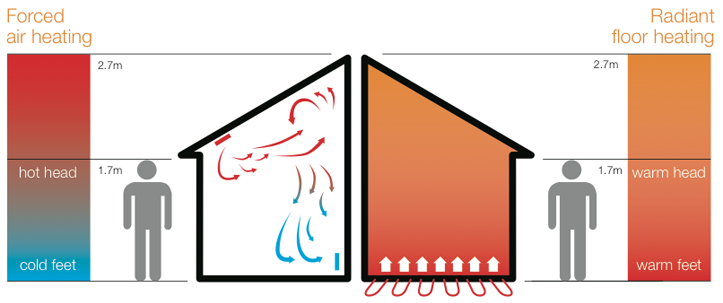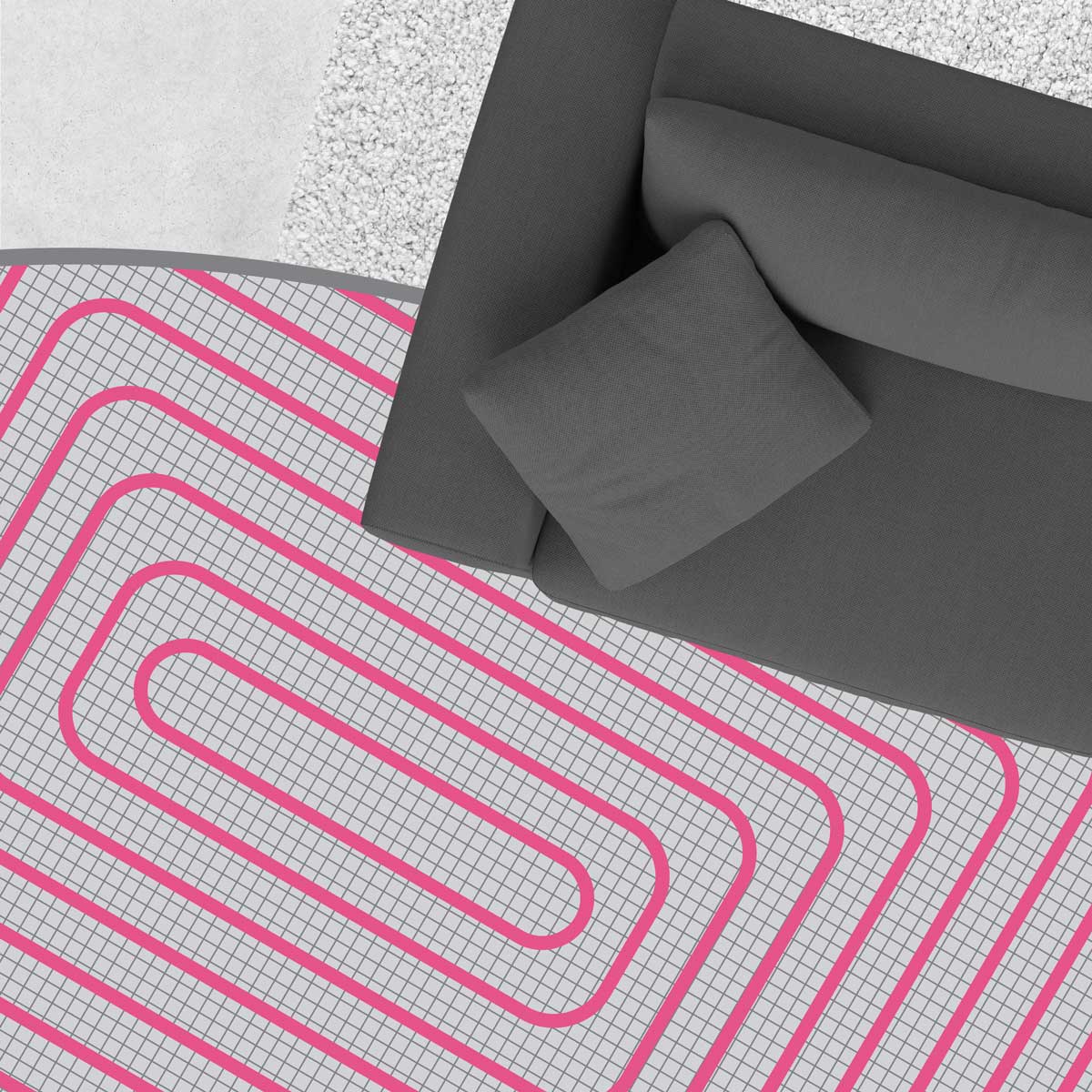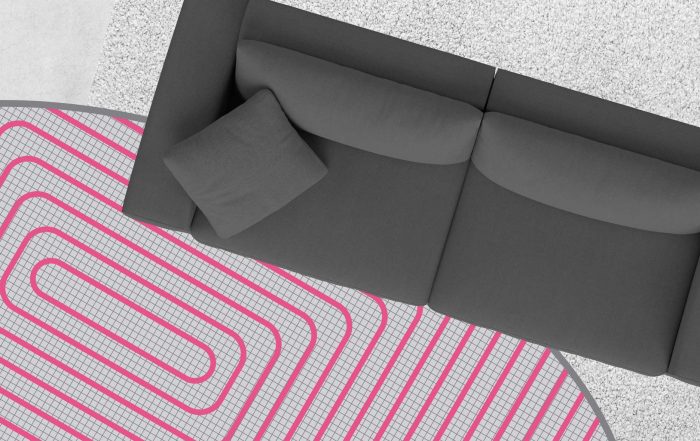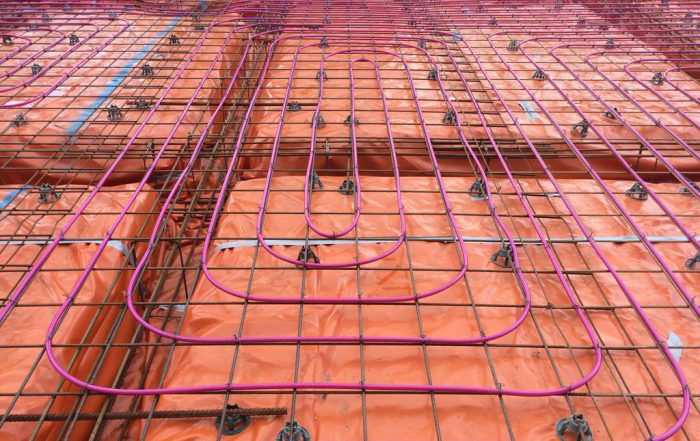Building a new home in South Australia involves investing in the right heating system to suit your needs. Most people have heard of ducted air conditioning or other forced air systems. We’re here to discuss radiant heating and hydronic underfloor heating as an alternative to conventional forced air systems.
Hydronic underfloor heating uses radiant heat to warm your home. The picture below shows how radiant heating warms the whole body compared to convection or forced air heating which primarily warms only your upper body. With forced air systems, air moves across ceilings and other surfaces, leading to high thermal losses and additional energy being consumed to make up for these losses. With a radiant floor heating system, however, the temperature of the floor surface is higher than that of the air, resulting in a more consistent and even heat throughout your home.

Reasons to use radiant heating
Comfort – Radiant heating maintains an even temperature with no drafts, hot spots or cold spots. This means you can enjoy fresh air in your home with no dryness or stuffiness. Radiant heating is also silent when in operation.
Safety – There are no exposed flames or hot surfaces, ducts or radiators, or moving parts to worry about when you use a radiant heating system. This makes it incredibly safe for a young family.
Health – Radiant heating is ideal for people with respiratory problems, allergies or asthma because there is no airborne dust or fumes, and no drafts to cause chills.
Convenience – A radiant heating system uses thermostats and time switches to look after the heating system, so you can simply set and forget! They are easy to install when building, extending or renovating, and no floor or wall space is lost. There are also no pilot lights to re-light or wood to collect. Simple, convenient and effective!
Economical – Our radiant heating systems have controllable zones, so it’s possible to have individual zone thermostat control with different temperatures in each zone. Thermal comfort can be achieved at lower air temperatures than conventional forced air systems, making it more economical to run. It’s also virtually maintenance free as there are no moving parts.

How hydronic floor heating works
Hydronic radiant heat uses small pipes, water and an energy source of your choosing, making hydronic underfloor heating systems efficient enough to use as a heating solution for your entire home.
Pipes beneath the floor are used to circulate heated water throughout the area. As the water flows through the system, the heat is released. Water can be heated in a couple of different ways: gas-fired boiler or electric heat pump.
Some underfloor hydronic systems supplement these primary heat sources with solar energy. Choosing a solar-assisted system is environmentally friendly, and it can further reduce your heating costs. The best choice for heating your system depends on the size of your home and where it’s located. We can advise on which method will be the most efficient. A system of pipes channels water from this heating source to the pipes under different rooms of your home, which means that you can set different temperatures for different rooms. In new home installations, the pipes that run through individual rooms are put in place, and a concrete slab is poured over top. Heat from water moving through the pipe transfers into this concrete slab, which then warms the room.
Hydronic heating technology is constantly evolving, especially in regard to the required water temperature needed to reach desired heating levels. Hydronic radiant heat can create temperatures that are much more consistent throughout a home. No more chills walking from your living room to your kitchen! If you want different temperatures in different rooms at different times – such as cooling off your bedroom when it’s time for bed – we can recommend a thermostat that can be programmed to do so.

Efficiency of hydronic underfloor heating
Hydronic radiant heat can be one of the most efficient ways to heat your home. The nature of the system limits the amount of energy that is wasted. In fact, hydronic underfloor systems can reduce your energy costs, which means that they pay for themselves over time. They can also increase the value of your home.
By comparison, forced-air systems can lose so much heat through ducts that their efficiency is reduced by half. In a hydronic system, there’s significantly less heat loss. Several other factors contribute to the efficiency of hydronic heat. Since the heat comes from the floor, it can keep you comfortable at a lower set temperature than would be required for the same comfort from a traditional forced-air system. This method of heat distribution also means that the system doesn’t have to run for as long to heat up or to maintain the set temperature. It’s especially effective in areas where forced-air heat can’t keep up with your heating needs.
In addition to being installed beneath flooring, hydronic radiant heat systems can also be installed in walls and ceilings, which can help you heat trouble spots in your home.
Hydronic underfloor heating systems create a uniform temperature in your home because they don’t rely on circulating air to provide warmth. This means that even the corners of your favourite rooms will be adequately heated. Additionally, you can use a programmable thermostat to set different temperatures in different rooms or at different times of the day. Programmable thermostats have been associated with both reduced heating costs and increased comfort.
The efficiency of hydronic systems can be further improved by careful design and adequate insulation. We are radiant heating specialists here at Glow, and we can help you create a system that maximises efficiency and keeps your home comfortable all year round.




